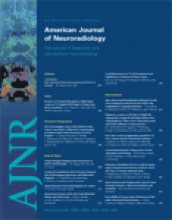Abstract
BACKGROUND AND PURPOSE: Histogram analysis can be applied to dynamic susceptibility contrast (DSC) perfusion MR imaging datasets and can be as effective as traditional region-of-interest (ROI) measurements of relative cerebral blood volume (rCBV), an operator-dependent method. We compare the routine ROI method with histogram analysis in the grading of glial neoplasms.
MATERIALS AND METHODS: Ninety-two patients underwent conventional and DSC MR imaging. Routine rCBV (rCBVmax) measurements were obtained from ROIs of the maximal abnormality within the glioma. Histogram analysis rCBVT was performed with an ROI drawn around the maximal tumor diameter. Spearman rank correlations measured associations among glioma grade, rCBVmax, and histogram measures. Mann-Whitney tests compared grade with respect to rCBV and histogram measures. Logistic regression and McNemar test compared the utility of rCBVmax and histogram measures for detecting high grade gliomas.
RESULTS: Routine rCBVmax analysis showed significant correlation with grade (r = 0.734, P < .001). Histogram rCBVT metrics showed significant correlation with grade (P < .008); the 3 highest were rCBVT SD, SD50, and mean25 (r = 0.718, 0.684, and 0.683, respectively). Grade could be predicted by rCBVmax (P < .001) as well as rCBVT (P < .008). Three rCBVT histogram measures (SD, SD25, and SD50) detected high-grade glioma with significantly higher specificity than rCBVmax when the diagnostic tests were constrained to have at least 95% sensitivity.
CONCLUSION: rCBVT histogram analysis is as effective as rCBVmax analysis in the correlation with glioma grade. Inexperienced operators may obtain perfusion metrics using histogram analyses that are comparable with those obtained by experienced operators using ROI analysis.
- Copyright © American Society of Neuroradiology












